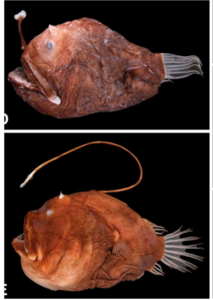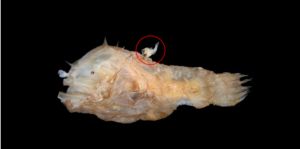Swann, J. B., Holland, S. J., Petersen, M., Pietsch, T. W., & Boehm, T. (2020). The immunogenetics of sexual parasitism. Science.
Some people would tell you that they believe in big romantic gestures, while others believe in small, thoughtful actions. But would you alter your immune system for love?

Well, deep-sea anglerfish would. Most of us know deep-sea anglerfish because of the shiny apparatus attached close to their heads, much like carrying a torch in a dark room. Just like this adaptation, deep-sea anglerfish have found out ways to survive in the deep and dark ocean. Another remarkable adaptation is sexual dimorphism, which means that the opposite sexes of a species exhibit different characteristics apart from sexual organs. The male anglerfish are dwarfed compared to the females and mostly grow up to 6-10 mm only, which could be about 60 times smaller than females. This difference in sizes leads to some awkward mating behavior. The males attach themselves to gigantic females temporarily or permanently. Sometimes more than one male attaches to one female. Now, this is where it gets interesting; some of these attachments involve the fusion of skin and, ultimately, the circulatory systems (hearts, lungs, blood veins, etc.). Think of them like the conjoined twins. And this is where the questions that scientists like Jeremy Swann and their teams are trying to answer arise.
Our immune systems are designed to reject any foreign tissue that tries to attach to our bodies. Hence during the organ or the tissue transplant, the doctors have to make sure that the donor organ matches the recipient’s system perfectly, or they have to suppress the recipient’s immune system to avoid rejection of the transplant. So how are the deep-sea anglerfish tricking their immune systems into forming such pairs? If they suppress their immune systems, won’t they become prone to various infections? The scientists hypothesized that maybe the genes of the same anglerfish species are very similar. The immune systems of anglerfish with similar genes – just like conjoined twins – don’t try to fight each other off. Another possibility could be that the anglerfish have a way to identify genetically similar mates, or they have altered their immune systems in a way that does not reject a foreign tissue but somehow prevents them from infections too.

In this study, the scientists took anglerfish pairs that do not attach at all, pairs that connect temporarily, pairs that link permanently, and pairs that attach permanently with more than one male. They looked at how different are the genes between males and females and examined the genes that determine compatibility between anglerfish pairs. They found a lot of different genes amongst the first two groups but substantially less in the last two groups. Genes carry information about an organism, like what they are and how do they look. If an organism encounters dissimilar genes (dissimilar information), then the body tries to fight it off thinking of it as an invader. Even though the variety of genes amongst the permanently attaching groups was not as diverse as the temporarily attaching pairs, the females still contained variations (information) that were not found in their male counterparts. The variety of genes between males and females means that anglerfish attachments are actually different from conjoined twins, who share very similar genes.
Next, the scientists looked for the genes that help the T cells reject a foreign cell. T cells are the tiny fighters that prevent us from foreign invasion as they fight off infections. Remarkably, these helper genes were absent in the permanently attaching species. Some of these permanently attaching species seem to have severely impaired their immunity. Hence the loss of immune response and the permanent attachments coexist. And the question remains whether permanent attachments are so beneficial that the immune response is suppressed or the changes in the immune system helped the attachments.
Overall, the scientists found that anglerfish employ different methods to trick their immune systems. While the temporarily attaching anglerfish only slightly reduces the response of its immune system, the permanently attaching species significantly reduces the response, to an almost negligible level in extreme cases. The scientists further suggest the temporary attachment could be an ancestral step towards permanent attachment. That means that the temporarily attaching fish evolve by losing their immune response to the permanently attaching fish. The reduced response of the immune system raises the most critical issue of increased vulnerability towards parasitic infections. It is possible that anglerfish have developed an entirely new kind of defense system by reorganizing their innate immune system. Even though there is a loss of genes that help T cells, some fundamental genes are still intact and may be utilized in ways unknown to us yet.
Hi, I am a Ph.D. student at the National Institute of Oceanography, India. I am currently studying the particulate and dissolved organic matter dynamics in the central and eastern Arabian Sea. I am also interested in the effects of climate change on marine systems, as well as outreach and science communication. My interest in science communication stems from the lack of effective scientific outreach in my country and I wish to contribute to improving that. In my spare time, I like to read non-fiction and learn about things I didn’t know existed.

